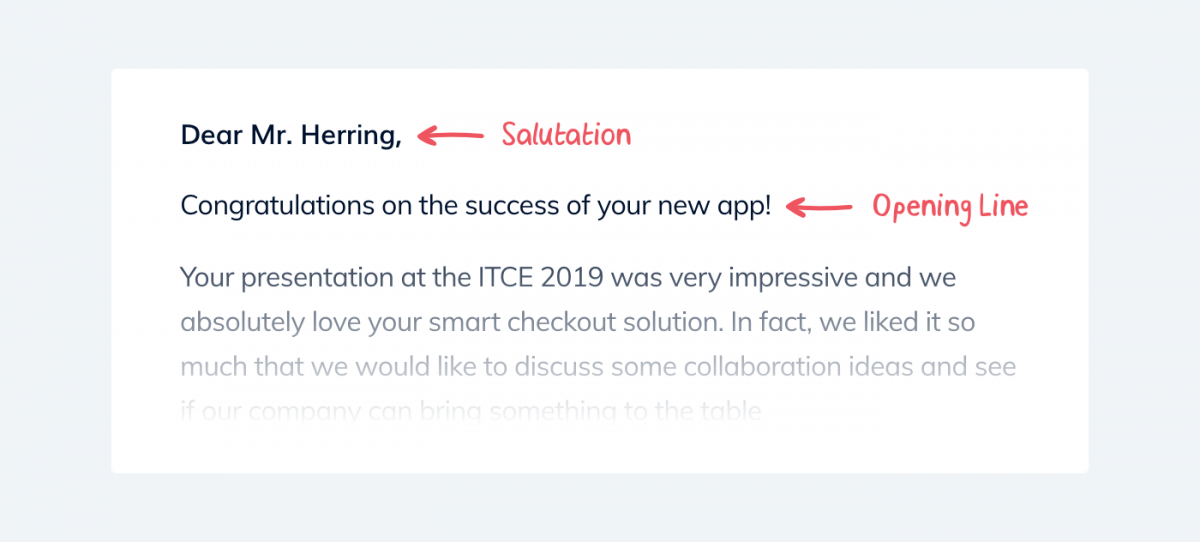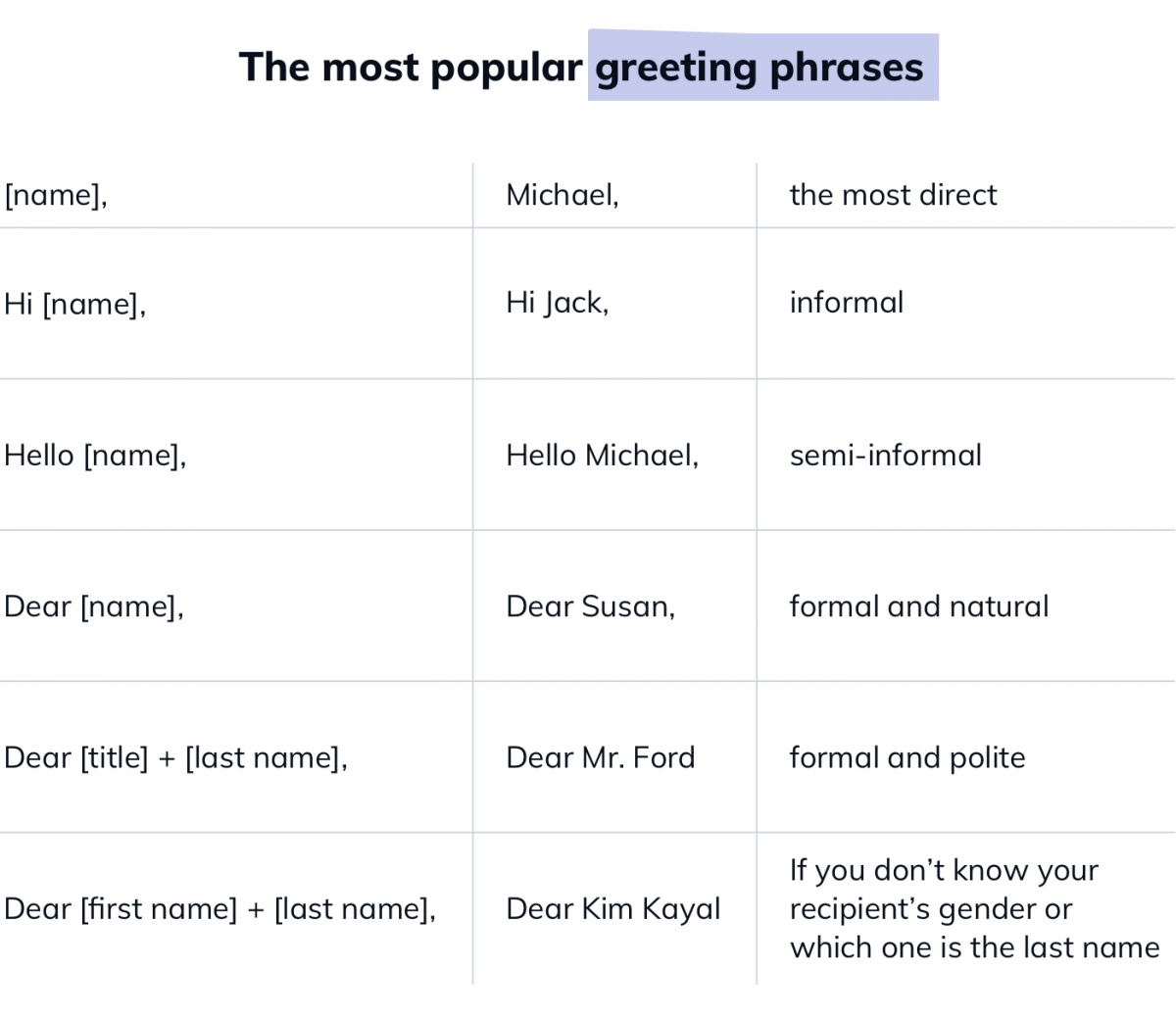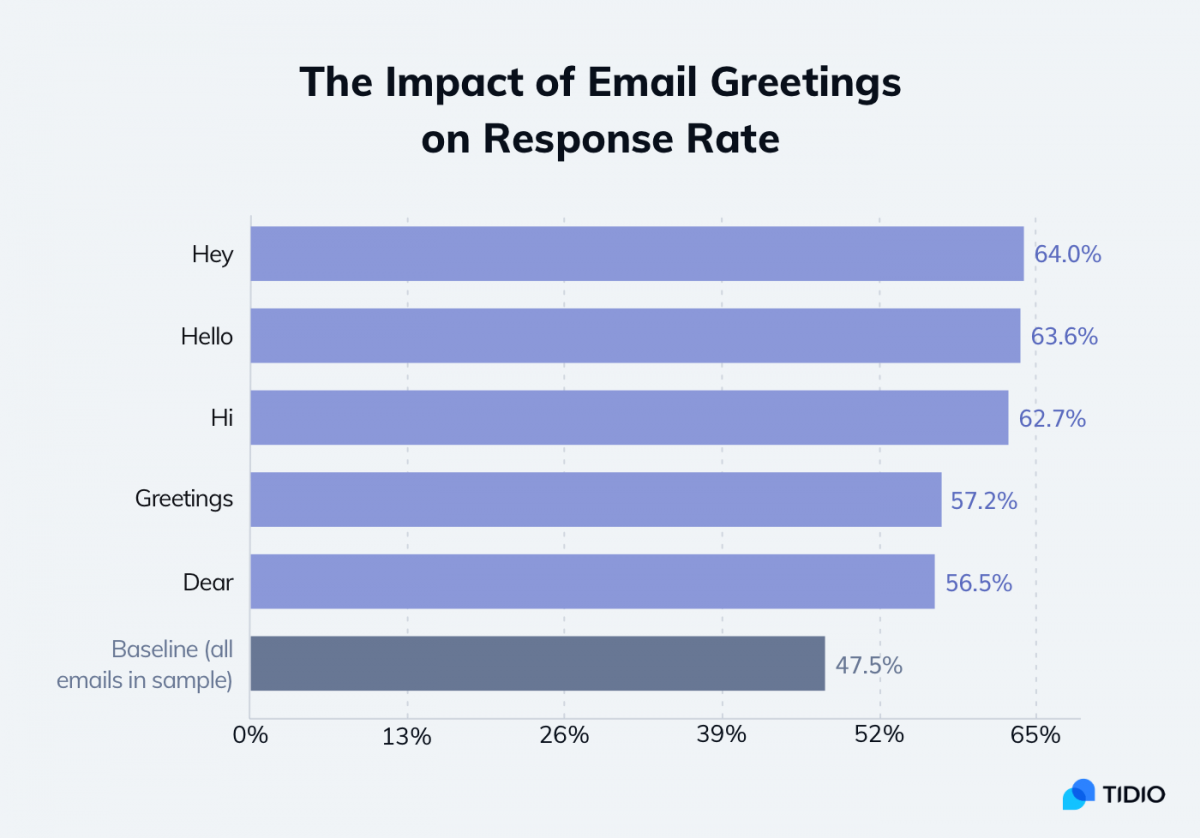How to Start a Letter if You Don't Know the Person
E-mail etiquette has many conventions that you need to find if you desire to appear apparent. Some of them are regional or linked to a detail type of correspondence.
Are you not certain how to start an email, what email greeting to use, or what the opening line should say? This guide volition help you make the best choice.
On top of that, we'll share not bad electronic mail opening lines and killer techniques to engage the recipient and make them actually want to reply.
In this article, you will larn:
- Which email salutations to use
- How to starting time an email
- All-time email opening sentences
Utilise a chatbot to build your mailing listing
Spare five minutes to set up a chatbot that volition aid you lot collect leads and segment your audience.
Larn about chatbots
Want to explore other email-related areas? Have a look at these manufactures:
- 25 Client Service E-mail Templates [+Best Practices]
- 5 Easy Steps to Build an Email Listing from Scratch [for Free]
- How to Create a Professional Electronic mail Signature [Tips & Examples]
- ten Best Electronic mail Marketing Templates [Complimentary Download]
- How to Write Email Subject Lines to Boost Open up Rates [Examples]
- Complimentary Electronic mail Newsletter Templates & Examples
- Professional Email Header Design: 7 All-time Practice Examples
- How to Write a Professional Email [E-mail Format & Examples]
- Best Time to Ship Emails: What Studies & Practice Tell Usa
The well-nigh important part of every email—like with traditional messages—is to found and maintain a connection. Information technology doesn't thing if it is an email campaign, business communication, or a cover letter. It should always exist based on mutual respect.
Always first your emails with a salutation (greeting phrase). It is a matter of convention that is an integral part of proper e-mail format.
What is a salutation in an email?
In the context of correspondence, a salutation is a greeting. The most mutual salutation in the English language is "Dear" and information technology can be used in almost situations. Salutations are normally followed by the recipient's first proper noun or championship + the final proper name, due east.grand. "Dearest Emmett", "Dearest Dr. Brown", "Dear Professor Chomsky".

Some follow-up emails don't need to starting time with a greeting, especially when they are quick replies that happen on the same solar day. Just if y'all are writing to someone for the first fourth dimension or sending common cold emails, brand certain to use a salutation.
Hither are the most popular e-mail greeting phrases (a.k.a. email salutations):
ane. [Proper name], (the well-nigh direct)
Sometimes you don't need to say hello or goodbye at all. Your recipient's name is enough. Try to think of it as a gentle nod followed by speaking someone's first proper name. It works in all kinds of situations and information technology fits email correspondence too. Still, information technology is non the most pop selection and it may be interpreted in several ways. If you don't desire to appear also direct, information technology'due south amend to stick to other greetings.
2. [Hullo [Name], (breezy)
"Hi" + the first name is the nearly universal salutation. Today it is appropriate in nigh every context. It works bully in concern emails and gives an immediate sense of friendliness. At the same time, it is perceived as a neutral option by most internet users. It is informal but it doesn't mean that it is rude—today's culture of online advice is much more relaxed.
three. Hello [Name], (semi-informal)
"Hello" is a more formal greeting than "Hi" and less formal than "Dear." Information technology may seem to be the best of both worlds. A good compromise, right? Only it isn't. Information technology is neither formal nor breezy and tends to stand out. Technically, there is nothing incorrect with it—but it is better to get one way or another.
4. Dear [Name], (formal and natural)
"Love" is the traditional salutation used in correspondence. It is more mutual in letters than emails, especially when we combine it with a first name lone. In informal emails, it may come off equally pretentious. If the slightly archaic tone is what y'all're afterwards then go for information technology.
v. Dear [Title/Honorific] + [Last Proper name], (formal and polite)
This combination is the most mutual greeting used in formal emails and letters. Let'due south assume that you are a student who needs to write an e-mail to a professor. Or you are looking for a job and y'all want to prepare a squeamish encompass letter. "Dearest" + title + the last proper name is pretty much your only choice. It is the standard salutation when you need to accost your "superiors."
six. Dear [Beginning Name] + [Terminal Name], (gender unknown)
This way of starting an email comes in handy when yous desire to be formal merely encounter names like Morgan, Rio, or Sasha. In general, honorifics that imply gender are frowned upon. Since there is no consensus about alternatives, this combination seems to be the safest choice.
7. Hi there, (to a group)
You can use this greeting if y'all are non sure well-nigh someone's proper noun or yous are addressing a group of recipients. "Hi" also works in those situations. However, adding "in that location" can also be handy when you are sending mass marketing emails. Yous can utilize it as a default placeholder give-and-take that is displayed when the recipient's proper noun is unknown. Replacing "Hi Harry," with "Hi there," is easier and better than using a blank. Just think about it—"Hi ,"? It looks like something typed in by someone who uses a reckoner for the starting time time in their life.
8. Greetings, (to a group)
This one is also quite universal and you can use it when addressing both groups and individuals. You don't demand to add a name after "Greetings," which makes it another good option when we don't know information technology. Some may, nonetheless, perceive information technology as slightly formal and impersonal. Merely it doesn't have to be a bad thing.
Salutations combined with names are followed by a comma (or a semicolon in very formal correspondence). Notwithstanding, the opening line of the kickoff line of the main body of your email should be treated as a new sentence and the first alphabetic character should be capitalized.

Detect:
"Love Mark," is always written without a comma between the salutation and the name. However, in the past "Howdy, Mark," (or "Hello, Mark,") with a comma used to be perceived as more correct than "Hi Marker,". Recently, the second option has get more than popular and is preferable. One comma after the proper noun looks more aesthetic than ii commas shut together.
If you want to use an honorific (Dear Mr. Smith/Ms. Smith), yous don't need to use total names. The most pop option is an honorific followed by the final name of a person. Nonetheless, assuming ane'due south gender may exist perceived as offensive. The gender-neutral honorific is "Mx."
"How-do-you-do" and "Hello" can be used without a name. It is the best option for informal greetings. If you lot don't know your recipient's name, you can use one of the more than universal welcoming phrases such every bit:
- Hi at that place
- Greetings
In some cases you can write something like:
- Good morning
- Good afternoon
But notice that they make your email sound more like an declaration. These greetings come useful when at that place are multiple recipients. However, it is always ameliorate to address your email to a specific person rather than a grouping of people.
Double-cheque your recipient's name earlier sending your emails. A misspelled name won't make a very adept first impression. And it is usually very easy to discover anyone on social media, LinkedIn, or their company's website.
If you don't know a person's proper name, you can besides use their chore title.
- Dear [Job Position] (east.g. Dear Marketing Manager)
Some email greetings appear to have higher response rates. According to a study, emails that commencement with "hi", "hullo", and "hey" are slightly better than "dear X" at getting a reply (by about 7%). Information technology is also worth noticing that including whatever salutation increases the response charge per unit.

There are also some greetings that information technology is safer to avoid, for example:
⛔ Hey! (Information technology might exist received as likewise informal)
⛔ Dear Sir/Madam (This is a very formal greeting and it sounds strong)
⛔ To Whom It May Business concern (This is imprecise and tends to exist ignored)
Y'all shouldn't sound too formal, just sometimes it is safer. Don't try to fraternize if you have just begun exchanging business correspondence with someone you don't actually know that much.
How to Start a Formal Email Exercise you want to keep the right tone when writing formal emails? Check out: How to Beginning a Professional person Email
Electronic mail opening lines are the offset sentences of your electronic mail message. Don't confuse them with email subject lines. Both—subject and opening lines—are important and assistance you catch your recipient'due south attention.
The number of emails sent every year grows much faster than the number of unique email users. It ways that we receive more and more emails per 24-hour interval.
Well-written private, marketing, and business emails should show that you respect other people's time. Usually, it'due south best to get directly to the point at the very get-go of your email.
There are four basic types of e-mail opening lines that work best:
- Offering value
- Request questions
- Boosting ego
- Starting a conversation
They employ different strategies of approaching the recipient, and yous need to determine which 1 of them is all-time in a given state of affairs.
Business Email Opening Sentences
Business writing should e'er exist more focused than informal emails. A good opening line must be connected with your e-mail bailiwick or at least make a seamless transition.
one. Electronic mail Opening Lines That Offer Value
Hint at a potential benefit or a solution to their problem.
Email opening line examples that offer value:
- I'm reaching out because . . . [there is a fashion your recipient'south business tin do good from this e-mail substitution and your cooperation]
- I've noticed that . . . [a trouble occurred] and I believe that I can assist yous in [solving the trouble].
- I'g sure you will be happy to learn . . . [that something of interest happened and is a golden business opportunity]
ii. Email Opening Lines That Ask Questions
Ask a question and permit them limited their opinion or ask for assist. People engage more than when they feel somebody needs them or is interested in what they take to say.
Email opening line examples that ask questions/enquire for help:
- Does your company want to . . . [achieve a particular goal or make a strategic decision]?
- Have you lot heard nearly . . . [the most contempo success of the recipient's competitor]?
- Would you like your concern to . . . [increase acquirement past Twenty%/convert more leads into sales/join the top ten businesses in a given field]?
3. Electronic mail Opening Lines That Boost Ego
Start with a compliment. Show your admiration for something your electronic mail receivers or their businesses accomplished.
Electronic mail opening line examples that boost the recipient'due south ego:
- Congratulations on . . . [recent accomplishment]
- I loved your contempo . . . . It [helped me realize/notice something which I appreciate]. I'grand contacting y'all regarding . . . [the reason you lot are writing this electronic mail]
- I'thousand impressed with the way you . . . [solved a trouble/achieved something challenging]
- I would be very grateful for your advice on . . . [the subject your e-mail recipient is an expert on]
4. Electronic mail Opening Lines That Utilise Contextual Conversation-Starters
Refer to a contempo meeting, an event, or a person to introduce the subject and kick off a conversation.
Email opening line examples that are topical:
- We spoke on [date] most [whatsoever you lot had talked about]. I'd like to discuss [the angle you would like to discuss that would option upwards a conversation where you left off terminal fourth dimension]
- [Name of a shared contact] suggested I get in touch on with yous regarding [the topic you desire to address]
- It was great to see your company at [an industry event/awards]!
An alternative version (with a twist):
- I saw [your email receiver's competitor] at [an industry event/awards]. I remember [a telephone call to action or reassurance that you side with your email recipient].
Email Templates
Email writing can be a daunting task. In some cases, specially when you write emails to your customers, information technology's all-time to use email templates. You can access a collection of 260+ unique email designs that usually need only small copy tweaks. Create your free Tidio account to try them out and send beautiful emails in minutes.
- Email Opening Lines to Scout out For
You should bear in mind that some of the common email formulas and phrases have lost their potency over the years:
⛔ Email opening lines that are overused or don't work:
- Did you enjoy your [weekend/vacation/holiday]? It looks forced and it can be an intrusion into somebody'southward personal life—non a good pick if you lot are non friends.
- Did you know that [curious fact]? It may come across as patronizing. You can take hold of someone's attention past throwing at them an interesting statistic that they near probably don't know, just you don't demand to rub it in their faces.
- I would like to innovate myself. Don't announce it. Just do information technology if yous really demand to. Nevertheless, it is not the all-time opening line. It'due south improve to become straight to the betoken. Your correspondence partners will check your email signature anyway.
Before you lot send an important e-mail, remember to go through this checklist:
- My email accost looks professional and has my company'due south domain at the end
- I checked the BCC and CC settings when typing in the recipient(s)
- The subject line of my email is descriptive, clear and it has no typos
- I accept used an advisable salutation and manner of addressing the recipient
- My opening line is intriguing and it uses i of the techniques described in the article
These rules use to concern and personal emails. However, marketing emails are an entirely dissimilar fauna. Frequently, they rely on the interplay between words and visuals. You can try out free email marketing software to create beautiful email designs in minutes.
jenningstoret1941.blogspot.com
Source: https://www.tidio.com/blog/how-to-start-an-email/
Post a Comment for "How to Start a Letter if You Don't Know the Person"